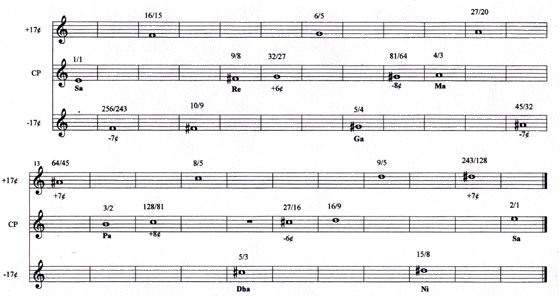SRUTI
AS APPROXIMATED IN 72 TONE EQUAL TEMPERAMENT
SRUTI IN E
The +/- one
keyboard idea makes perfect sense.
Intervals based on a chain of perfect fifths from the tonic all fall on
the
CP keyboard
... 128/81, 32/27, 16/9, 4/3, 1, 3/2, 9/8, 27/16, 81/64, ...
except the extreme ends of the chain where the error would be about 10c
from
CP
256/243, ... ... , 243/128
Intervals based on a chain of perfect fifths from the major third 5/4
all
fall on the -17c keyboard
10/9, 5/3, 5/4, 15/8, 45/32
Intervals based on a chain of perfect fifths from the minor third 6/5
all
fall on the +17c keyboard
64/45, 16/15, 8/5, 6/5, 9/5, 27/20
So that covers all 22 srutis, as well as standard Western triadic harmony.
In essence, the srutis give an untempered 12-tone scale, with two different
versions of most of the 12 tones, depending on whether the usage is
Pythagorean (based only on fifths 3/2) or "5-limit" (based also
on thirds
5/4 or 6/5). Makes a great scale for standard harmony...
Fri, 4 May 2001 12:52:17 -0700
Canright, David
The ´sruti is not a tempered interval. Not all srutis are equal . . .
. . . Like every practical division of the octave, the division of the srutis is theoretically insufficient, . . .
The term ´sruti, like the Greek quarter tone, refers to the displacement of a note by an interval smaller than a half tone in order to obtain a harmonically accurate interval.
... Western . . . notation is in fact based on the triple septenary of seven naturals, seven sharps, and seven flats. If the octave is added, this gives 3 x 7 + 1 = 22. [Daniélou, Alain, Music and The Power of Sound, Inner Traditions, Rochester, Vermont, 1995, pp81-82]

